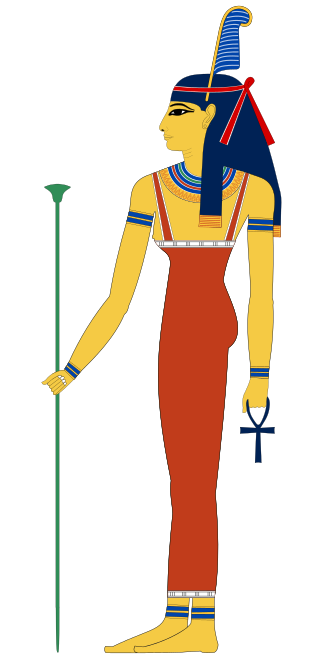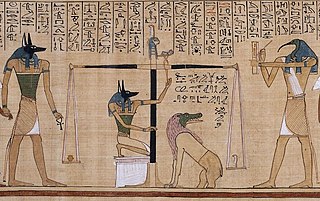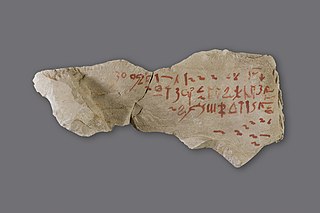The Instruction of Ankhsheshonq (or Ankhsheshonqy) is an Ancient Egyptian papyrus that has been tentatively dated to the Ptolemaic period, although the content may be earlier in origin. It contains an introductory narrative and a list of maxims on many topics, its style has been described as pragmatic and humorous. The papyrus was obtained in 1896 by the British Museum (papyrus #10508).
It is twenty-eight pages long, with major damage on pages 1–2 and 24–28.

Papyrus is a material similar to thick paper that was used in ancient times as a writing surface. It was made from the pith of the papyrus plant, Cyperus papyrus, a wetland sedge. Papyrus can also refer to a document written on sheets of such material, joined side by side and rolled up into a scroll, an early form of a book.

Maat or Maʽat comprised the ancient Egyptian concepts of truth, balance, order, harmony, law, morality, and justice. Ma'at was also the goddess who personified these concepts, and regulated the stars, seasons, and the actions of mortals and the deities who had brought order from chaos at the moment of creation. Her ideological opposite was Isfet, meaning injustice, chaos, violence or to do evil.

The Book of the Dead is an ancient Egyptian funerary text generally written on papyrus and used from the beginning of the New Kingdom to around 50 BC. The original Egyptian name for the text, transliterated r(ꜣ)w n(y)w prt m hrw(w), is translated as Book of Coming Forth by Day or Book of Emerging Forth into the Light. "Book" is the closest term to describe the loose collection of texts consisting of a number of magic spells intended to assist a dead person's journey through the Duat, or underworld, and into the afterlife and written by many priests over a period of about 1,000 years. Karl Richard Lepsius introduced for these texts the German name Todtenbuch, translated to English as Book of the Dead.

The Elephantine Papyri and Ostraca consist of thousands of documents from the Egyptian border fortresses of Elephantine and Aswan, which yielded hundreds of papyri and ostraca in hieratic and demotic Egyptian, Aramaic, Koine Greek, Latin and Coptic, spanning a period of 100 years in the 5th to 4th centuries BCE. The documents include letters and legal contracts from family and other archives, and are thus an invaluable source of knowledge for scholars of varied disciplines such as epistolography, law, society, religion, language and onomastics. The Elephantine documents include letters and legal contracts from family and other archives: divorce documents, the manumission of slaves, and other business. The dry soil of Upper Egypt preserved the documents.

The Twelfth Dynasty of ancient Egypt is considered to be the apex of the Middle Kingdom by Egyptologists. It often is combined with the Eleventh, Thirteenth, and Fourteenth dynasties under the group title, Middle Kingdom. Some scholars only consider the 11th and 12th dynasties to be part of the Middle Kingdom.
Ancient Egyptian mathematics is the mathematics that was developed and used in Ancient Egypt c. 3000 to c. 300 BCE, from the Old Kingdom of Egypt until roughly the beginning of Hellenistic Egypt. The ancient Egyptians utilized a numeral system for counting and solving written mathematical problems, often involving multiplication and fractions. Evidence for Egyptian mathematics is limited to a scarce amount of surviving sources written on papyrus. From these texts it is known that ancient Egyptians understood concepts of geometry, such as determining the surface area and volume of three-dimensional shapes useful for architectural engineering, and algebra, such as the false position method and quadratic equations.
The Teaching for King Merykara, alt. Instruction Addressed to King Merikare, is a literary composition in Middle Egyptian, the classical phase of the Egyptian language, probably of Middle Kingdom date.

The Papyrus of Ani is a papyrus manuscript in the form of a scroll with cursive hieroglyphs and colour illustrations that was created c. 1250 BCE, during the Nineteenth Dynasty of the New Kingdom of ancient Egypt. Egyptians compiled an individualized book for certain people upon their death, called the Book of Going Forth by Day, more commonly known as the Book of the Dead, typically containing declarations and spells to help the deceased in their afterlife. The Papyrus of Ani is the manuscript compiled for the Theban scribe Ani; it is now in the British Museum.

The medicine of the ancient Egyptians is some of the oldest documented. From the beginnings of the civilization in the late fourth millennium BC until the Persian invasion of 525 BC, Egyptian medical practice went largely unchanged and included simple non-invasive surgery, setting of bones, dentistry, and an extensive set of pharmacopoeia. Egyptian medical thought influenced later traditions, including the Greeks.

A hypocephalus is a small disk-shaped object generally made of stuccoed linen, but also of papyrus, bronze, gold, wood, or clay, which ancient Egyptians from the Late Period onwards placed under the heads of their dead. The circle was believed to magically protect the deceased and cause the head and body to be enveloped in light and warmth, making the deceased divine. It replaced the earlier cow-amulet.
The Onomasticon of Amenope is an ancient Egyptian text from the late 20th Dynasty to 22nd Dynasty. It is a compilation belonging to a tradition that began in the Middle Kingdom, and which includes the Ramesseum Onomasticon dating from the end of the Twentieth Dynasty of Egypt, no earlier than the reign of Ramesses IX. Nine copies of the document are known, of which the original Golenischeff copy is the most complete. It is an administrative/literary categorization of 610 entities organized hierarchically, rather than a list of words (glossary). It is known from ten fragments including versions on papyrus, board, leather, and pottery.

Instruction of Amenemope is a literary work composed in Ancient Egypt, most likely during the Ramesside Period ; it contains thirty chapters of advice for successful living, ostensibly written by the scribe Amenemope son of Kanakht as a legacy for his son. A characteristic product of the New Kingdom "Age of Personal Piety", the work reflects on the inner qualities, attitudes, and behaviors required for a happy life in the face of increasingly difficult social and economic circumstances. It is widely regarded as one of the masterpieces of ancient near-eastern wisdom literature and has been of particular interest to modern scholars because of its similarity to the later biblical Book of Proverbs.
Sebayt is the ancient Egyptian term for a genre of pharaonic literature. sbꜣyt literally means "teachings" or "instructions" and refers to formally written ethical teachings focused on the "way of living truly". Sebayt is considered an Egyptian form of wisdom literature.

The Rhind Mathematical Papyrus is one of the best known examples of ancient Egyptian mathematics. It is named after Alexander Henry Rhind, a Scottish antiquarian, who purchased the papyrus in 1858 in Luxor, Egypt; it was apparently found during illegal excavations in or near the Ramesseum. It dates to around 1550 BC. The British Museum, where the majority of the papyrus is now kept, acquired it in 1865 along with the Egyptian Mathematical Leather Roll, also owned by Henry Rhind. There are a few small fragments held by the Brooklyn Museum in New York City and an 18 cm (7.1 in) central section is missing. It is one of the two well-known Mathematical Papyri along with the Moscow Mathematical Papyrus. The Rhind Papyrus is larger than the Moscow Mathematical Papyrus, while the latter is older.
The Papyrus Harris 500, alt. pHarris 500 or P. British Museum 10060, contains copies of the ancient Egyptian tales of The Doomed Prince and The Taking of Joppa, of love poems and of the Harper's Song from the tomb of King Intef. The papyrus dates from the Ramesside Period.

Egyptian literature traces its beginnings to ancient Egypt and is some of the earliest known literature. Ancient Egyptians were the first to develop written literature, as inscriptions or in collections of papyrus, precursors to the modern book.

Egyptian medical papyri are ancient Egyptian texts written on papyrus which permit a glimpse at medical procedures and practices in ancient Egypt. These papyri give details on disease, diagnosis, and remedies of disease, which include herbal remedies, surgery, and magical incantations. Many of these papyri have been lost due to grave robbery. The largest study of the medical papyri to date has been undertaken by Humboldt University of Berlin and was titled Medizin der alten Ägypter.
"The Contendings of Horus and Seth" is a mythological story from the Twentieth Dynasty of Egypt found in the first sixteen pages of the Chester Beatty Papyri and deals with the battles between Horus and Seth to determine who will succeed Osiris as king.

In Ancient Egyptian religion, Medjed is a minor deity mentioned in certain copies of the Book of the Dead. While not much is known about the deity, his ghost-like depiction in the Greenfield papyrus has earned him popularity in modern Japanese culture, and he has appeared as a character in video games and anime.